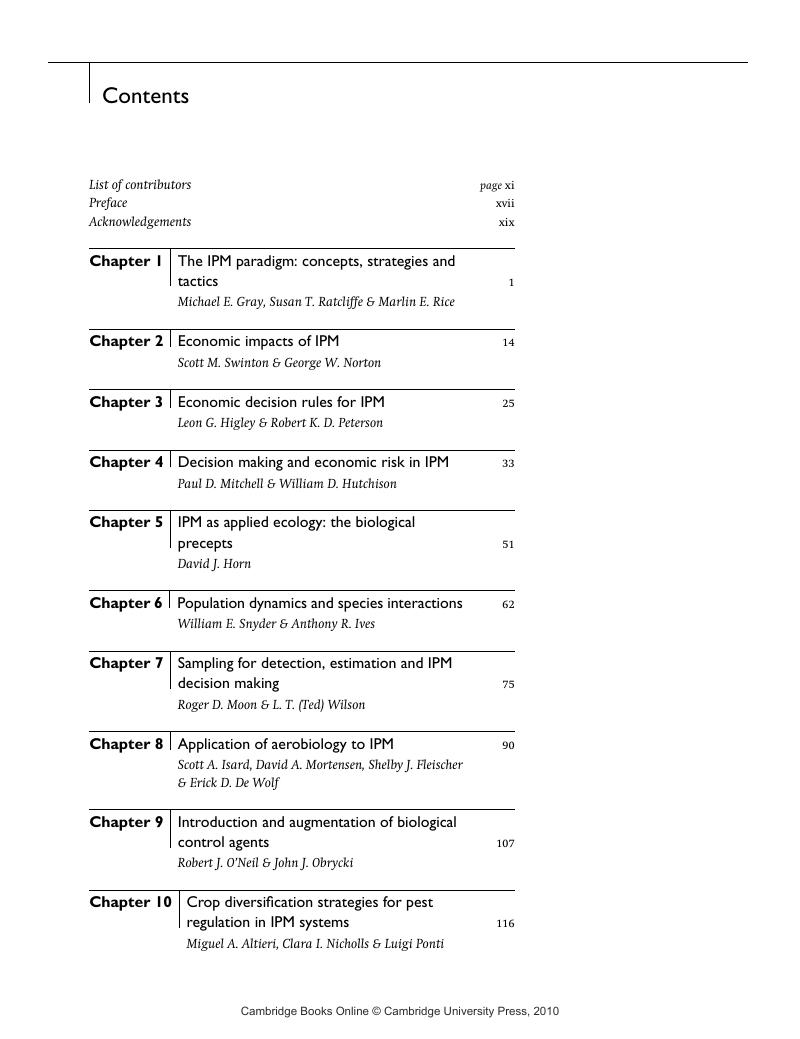Book contents
- Frontmatter
- Contents
- List of contributors
- Preface
- Acknowledgements
- Chapter 1 The IPM paradigm: concepts, strategies and tactics
- Chapter 2 Economic impacts of IPM
- Chapter 3 Economic decision rules for IPM
- Chapter 4 Decision making and economic risk in IPM
- Chapter 5 IPM as applied ecology: the biological precepts
- Chapter 6 Population dynamics and species interactions
- Chapter 7 Sampling for detection, estimation and IPM decision making
- Chapter 8 Application of aerobiology to IPM
- Chapter 9 Introduction and augmentation of biological control agents
- Chapter 10 Crop diversification strategies for pest regulation in IPM systems
- Chapter 11 Manipulation of arthropod pathogens for IPM
- Chapter 12 Integrating conservation biological control into IPM systems
- Chapter 13 Barriers to adoption of biological control agents and biological pesticides
- Chapter 14 Integrating pesticides with biotic and biological control for arthropod pest management
- Chapter 15 Pesticide resistance management
- Chapter 16 Assessing environmental risks of pesticides
- Chapter 17 Assessing pesticide risks to humans: putting science into practice
- Chapter 18 Advances in breeding for host plant resistance
- Chapter 19 Resistance management to transgenic insecticidal plants
- Chapter 20 Role of biotechnology in sustainable agriculture
- Chapter 21 Use of pheromones in IPM
- Chapter 22 Insect endocrinology and hormone-based pest control products in IPM
- Chapter 23 Eradication: strategies and tactics
- Chapter 24 Insect management with physical methods in pre- and post-harvest situations
- Chapter 25 Cotton arthropod IPM
- Chapter 26 Citrus IPM
- Chapter 27 IPM in greenhouse vegetables and ornamentals
- Chapter 28 Vector and virus IPM for seed potato production
- Chapter 29 IPM in structural habitats
- Chapter 30 Fire ant IPM
- Chapter 31 Integrated vector management for malaria
- Chapter 32 Gypsy moth IPM
- Chapter 33 IPM for invasive species
- Chapter 34 IPM information technology
- Chapter 35 Private-sector roles in advancing IPM adoption
- Chapter 36 IPM: ideals and realities in developing countries
- Chapter 37 The USA National IPM Road Map
- Chapter 38 The role of assessment and evaluation in IPM implementation
- Chapter 39 From IPM to organic and sustainable agriculture
- Chapter 40 Future of IPM: a worldwide perspective
- Index
Contents
Published online by Cambridge University Press: 01 September 2010
- Frontmatter
- Contents
- List of contributors
- Preface
- Acknowledgements
- Chapter 1 The IPM paradigm: concepts, strategies and tactics
- Chapter 2 Economic impacts of IPM
- Chapter 3 Economic decision rules for IPM
- Chapter 4 Decision making and economic risk in IPM
- Chapter 5 IPM as applied ecology: the biological precepts
- Chapter 6 Population dynamics and species interactions
- Chapter 7 Sampling for detection, estimation and IPM decision making
- Chapter 8 Application of aerobiology to IPM
- Chapter 9 Introduction and augmentation of biological control agents
- Chapter 10 Crop diversification strategies for pest regulation in IPM systems
- Chapter 11 Manipulation of arthropod pathogens for IPM
- Chapter 12 Integrating conservation biological control into IPM systems
- Chapter 13 Barriers to adoption of biological control agents and biological pesticides
- Chapter 14 Integrating pesticides with biotic and biological control for arthropod pest management
- Chapter 15 Pesticide resistance management
- Chapter 16 Assessing environmental risks of pesticides
- Chapter 17 Assessing pesticide risks to humans: putting science into practice
- Chapter 18 Advances in breeding for host plant resistance
- Chapter 19 Resistance management to transgenic insecticidal plants
- Chapter 20 Role of biotechnology in sustainable agriculture
- Chapter 21 Use of pheromones in IPM
- Chapter 22 Insect endocrinology and hormone-based pest control products in IPM
- Chapter 23 Eradication: strategies and tactics
- Chapter 24 Insect management with physical methods in pre- and post-harvest situations
- Chapter 25 Cotton arthropod IPM
- Chapter 26 Citrus IPM
- Chapter 27 IPM in greenhouse vegetables and ornamentals
- Chapter 28 Vector and virus IPM for seed potato production
- Chapter 29 IPM in structural habitats
- Chapter 30 Fire ant IPM
- Chapter 31 Integrated vector management for malaria
- Chapter 32 Gypsy moth IPM
- Chapter 33 IPM for invasive species
- Chapter 34 IPM information technology
- Chapter 35 Private-sector roles in advancing IPM adoption
- Chapter 36 IPM: ideals and realities in developing countries
- Chapter 37 The USA National IPM Road Map
- Chapter 38 The role of assessment and evaluation in IPM implementation
- Chapter 39 From IPM to organic and sustainable agriculture
- Chapter 40 Future of IPM: a worldwide perspective
- Index
Summary

- Type
- Chapter
- Information
- Integrated Pest ManagementConcepts, Tactics, Strategies and Case Studies, pp. vii - xPublisher: Cambridge University PressPrint publication year: 2008

